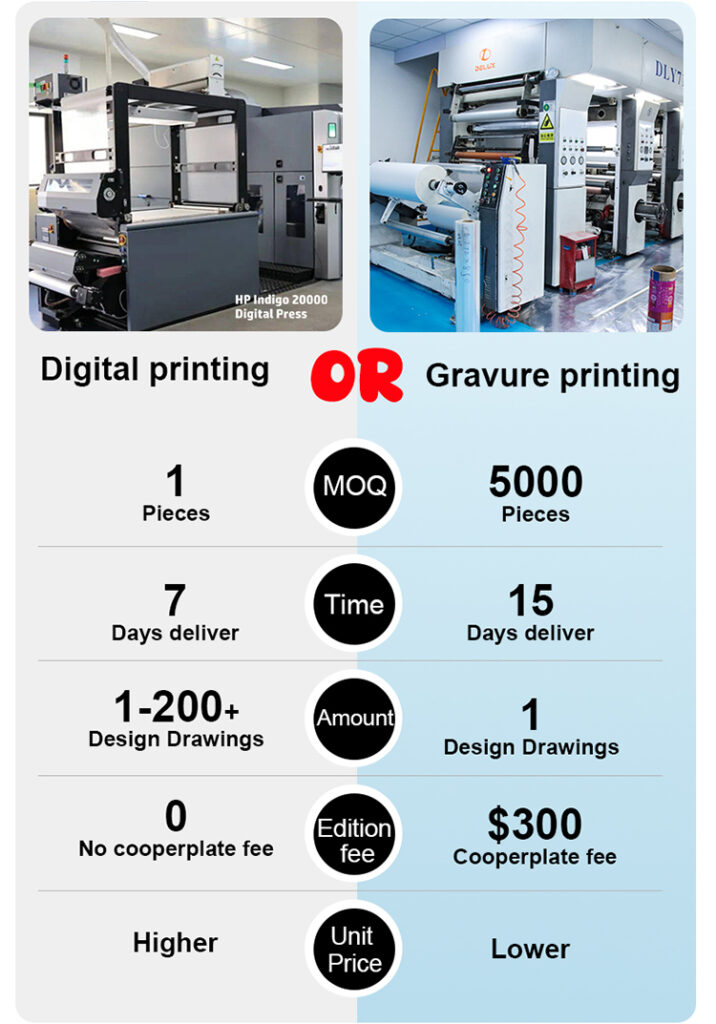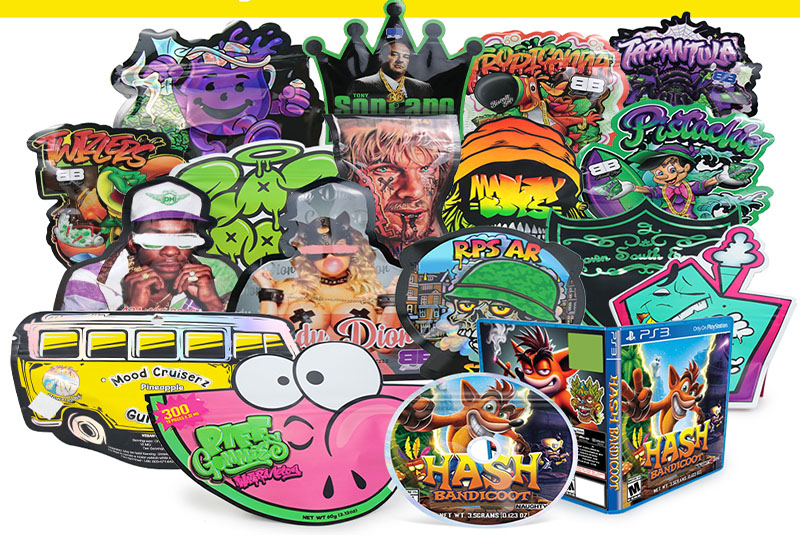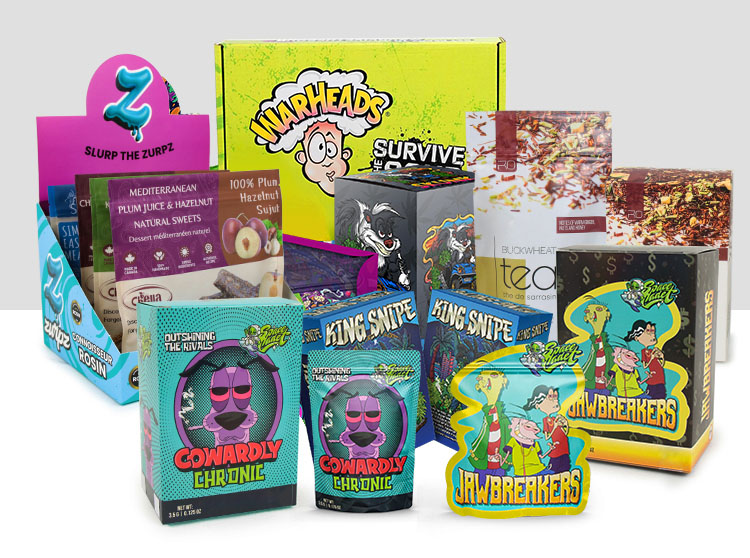How Can You Create Custom Mylar Bags for Your Brand?
Tired of generic packaging that doesn't reflect your unique brand? Your product is special, and its packaging should be too. But the customization process can seem daunting. Don't worry, we'll guide you through it seamlessly, creating Mylar bags that perfectly express your brand's personality.
Creating custom Mylar bags involves design conception, material selection, printing processes, bag shaping, and integrating functional details. As a source factory, we at FDXPACK assist you throughout the entire journey, from concept to finished product, ensuring every aspect meets your expectations and product needs.
Understanding this process empowers you to choose the best packaging solution for your products. It's not just about a bag; it's about conveying your brand image and enhancing product value. Let's dive into how to bring your custom Mylar bags from idea to reality, focusing on printing and unique shapes.
How Do We Make Custom Printed Mylar Bags?
Do standard, uninspired Mylar bags leave your brand in the shadows? Your brand story and visual identity deserve to be showcased with vibrant, precise printing. We can help your designs shine on your packaging.
The core of creating custom printed Mylar bags lies in transferring your design onto Mylar composite material using high-quality printing technology. We support complex multi-color designs, utilizing advanced printing equipment to ensure color vibrancy and pattern clarity, perfectly presenting your brand message and visual elements.
 mylar bag for ice cream, custom printing
mylar bag for ice cream, custom printing
Printing is the key step that breathes life into Mylar bags. A well-designed print can significantly enhance a product's shelf appeal and effectively communicate brand value. At FDXPACK, we understand the importance of print quality, which is why we've invested in advanced printing production lines and have an experienced team to handle every detail from the design draft to the final print.
Artwork Requirements
A good printing result starts with a qualified design file. To ensure print quality, we generally have the following requirements for artwork:
- File Formats: We prefer vector files such as Adobe Illustrator (.AI) or CorelDRAW (.CDR). For bitmap files like Photoshop (.PSD), ensure the resolution is sufficiently high. PDF format is also acceptable, preferably a PDF that contains vector information or high-resolution images.
- Color Mode: CMYK color mode is typically used for printing. If you have specific Pantone color requirements, please inform us in advance, and we will do our best to match them.
- Resolution: For designs that include images, the resolution should be at least 300 DPI to ensure clear, non-pixelated printing.
- Fonts: All text content should be converted to curves (outlined) or embedded in the file to avoid display errors due to missing fonts. This is very important when transferring files between computers.
- Bleed: Please allow for an appropriate bleed area (usually 3-5mm) in your design to prevent important content from being cut off during trimming.
Printing Process Selection

Based on your design complexity, order quantity, and budget, we will recommend the most suitable printing process: - Gravure Printing: This is the most common printing method for Mylar bags, especially suitable for large volume orders. It offers very high print quality, vibrant colors, and fine pattern details. The plate-making cost is relatively high, but the unit cost decreases with increased quantity. The inks used are environmentally friendly and meet food-grade standards [6].
- Digital Printing: Suitable for small batches, multiple designs, or orders requiring quick samples. Digital printing does not require plate making, offering flexible MOQs and the ability to print variable data. However, for mass production, its unit cost might be higher than gravure printing, and its performance on spot colors (like metallic inks) may differ. Our digital printing uses CMYK+W as common 5 color channels, and can also use V, G, O as spot color channels.
Our factory has multiple gravure printing lines capable of meeting most clients' demands for high-quality printing. We will provide the most suitable printing solution based on your specific situation. Before formal production, we will also provide digital proofs or printed film samples for you to confirm colors and effects. We will send you the arranged artwork with markings for sealing, tear notches, etc., in a color different from the print content for your confirmation before production.How Can You Get Custom Shaped Mylar Bags?
Tired of the same old standard rectangular bags? A unique bag shape can make your product instantly stand out on the shelf. We can create distinctively shaped custom Mylar bags based on your creative ideas.
Custom shaped Mylar bags are manufactured using specialized die-cut tools (cutting molds) based on your unique design. This allows the packaging to have an appearance different from traditional square or rectangular bags, such as curved edges, specific contours, or shapes that conform to the product itself, thereby creating highly recognizable packaging.
 decut mylar bag
decut mylar bag
In a competitive market, unique packaging shapes are an effective way to attract consumer attention and enhance brand recall. Imagine a bag shape that cleverly echoes your product features or brand story; it will undoubtedly increase consumer curiosity and purchase desire. For example, we have made stand-up pouches with rounded bottoms for some food clients, which are not only aesthetically pleasing but also facilitate product display.From Concept to Mold
The first step in realizing custom shaped Mylar bags is to transform your design concept into a practical production tool—the cutting die.
- Design Communication: You first need to provide a sketch, design drawing, or specific description of the bag shape you want. We will work with you to evaluate the design's feasibility, considering material properties, production complexity, and cost factors.
- Drawing Confirmation: Our engineers will create detailed die-cut drawings based on your design, clearly marking key parameters such as dimensions and curvatures. You will need to carefully review and finally confirm this drawing.
- Mold Making: Once the drawing is confirmed, we will arrange for the production of the specialized cutting die. The precision of the mold directly affects the final bag's forming effect, so we pay great attention to the mold's processing quality.
Advantages and Considerations of Custom Shapes
Advantages:
- Brand Differentiation: Significantly distinguishes you from competitors, enhancing brand recognition.
- Enhanced Appeal: Unique visual effects are more likely to attract consumer attention.
- Increased Perceived Product Value: Special packaging often conveys a more premium and thoughtful impression.
- Functional Matching: Sometimes, special shapes can better suit the product itself or facilitate consumer use.
Considerations: - Initial Cost: Custom die-cutting tools incur a one-time mold fee, which increases the initial project investment.
- Minimum Order Quantity (MOQ): Due to mold creation, custom shaped bags usually have higher MOQ requirements than standard bag types.
- Production Lead Time: Mold making takes time, potentially making the production cycle slightly longer than for standard bag types.
- Design Complexity: Overly complex shapes can increase production difficulty, affecting production efficiency and cost.
As an experienced packaging bag manufacturer, we will provide you with a detailed analysis of the pros and cons, helping you find the best balance between creativity and practical production.What's the Overall Process for Making Your Own Custom Mylar Bags?
Turning your packaging vision into a real Mylar bag might sound complex. Don't worry, partnering with us makes it a clear and methodical process.
Making your own custom Mylar bags typically starts with detailed requirement communication, followed by design finalization, material and feature selection, then sample confirmation, and finally, mass production, quality control, and shipment. We at FDXPACK will be with you every step of the way.

We are committed to making the customization process as transparent and smooth as possible. With 16 years of production experience, our factory has optimized its processes to ensure efficiency and quality. Here are the general steps when you partner with us for custom Mylar bags:Step 1: Consultation and Requirement Confirmation
- Initial Contact: You can reach me, Emma Xiao, through our website (www.fdxpack.com), Alibaba platform, or direct email (emma@fdxpack.com). Let me know what product you plan to pack and your general ideas for the bag (e.g., size, bag type, printing, special functional needs). If you're unsure about the material or thickness, tell me what you're packing, and I can recommend based on common practices for similar products [1][3].
- Requirement Detailing: We will ask key questions like:
- Bag Type: Do you need stand-up pouches, three-side seal bags, flat pouches, or other special types?
- Dimensions & Capacity: How large does the bag need to be? What weight or volume will it hold?
- Material Structure: What are your requirements for barrier properties (moisture-proof, oxygen-proof, light-proof), puncture resistance, and appearance (e.g., matte, glossy)? Mylar typically refers to high-barrier composites like PET/VMPET/PE or PET/AL/PE. Our Kraft paper bags, for instance, are lined with film to ensure they are suitable for long-term food preservation [5].
- Printing Design: Do you have artwork? How many colors need to be printed? Single-sided or double-sided printing?
- Quantity: What is your estimated order quantity? This affects pricing and production method choices.
- Additional Features: Do you need zippers (regular, child-resistant), tear notches, hang holes, transparent windows, etc.?
- Target Market & Certifications: Which countries will the product be sold in? Do you need certifications like FDA or BRC (we hold these)? Our products can be in direct contact with food [5].
Step 2: Quotation and Design Finalization
- Quotation: Based on your detailed requirements, we will provide a formal quotation including unit price, plate costs (for gravure printing), mold fees (for custom shapes), MOQ, and estimated lead time.
- Design Assistance & Confirmation: If you have artwork, please provide it in AI, PSD, CDR, or PDF format. We will check if the file meets printing requirements. If you don't have a design, we can offer design services (a small design deposit may apply, deductible from a future order). Before plate making, we will provide a final digital proof (JPG or PDF) for your written confirmation, ensuring all details like graphics, text, and dimensions are accurate. Please scan and test any barcode/QR code before production.
Step 3: Sample Making and Confirmation
- Existing Sample Reference: If you want to assess our material and print quality, we can send you some of our existing similar samples.
- Custom Samples: If you need pre-production samples made exactly to your design (like printed film proofs or handmade bag samples), this usually incurs a sampling fee and plate cost (for gravure proofs). Once samples are ready, we will send them to you for confirmation. When shipping samples, we typically mark them as samples on the PI and declare a low value to reduce your customs clearance costs.
Step 4: Order Confirmation and Production (Continued)
- Payment & Deposit: Once the contract or PO is confirmed, we usually require a deposit to start production, with the balance due before shipment or against a copy of the Bill of Lading, depending on the agreed terms.
- Material Preparation & Printing: We procure the specified raw materials. For printed bags, we proceed with plate making (for gravure) or direct digital printing setup.
- Lamination & Curing: The printed layer is laminated with other film layers to create the composite Mylar material. This is followed by a curing process (usually 1-2 days) to ensure proper bonding and eliminate any residual solvent odors from the inks [6].
- Bag Making: The cured, laminated rolls are then fed into bag-making machines, which cut, seal, and form the bags into the desired shape and size, adding features like zippers or tear notches.
- Quality Control (QC): Throughout the production process – from raw material inspection, printing checks, lamination strength tests, to final bag inspection – our QC team performs rigorous checks. This includes verifying dimensions, seal strength, print quality, and overall appearance to ensure they meet your specifications and our internal quality standards. We will keep communication records and file evidence for all communications with the client [2].
- Production Updates & Follow-up: We believe in keeping our clients informed. We will provide updates on the production status. We also set follow-up schedules, for example, 3, 5, or 7 days later, to regularly check in with clients who have shown intent to order, especially if they mentioned needing more time or if their design wasn't ready [4].
Step 5: Packaging and Shipment
- Final Inspection & Packaging: After production, a final inspection is done. The approved bags are then carefully packed into cartons, usually with inner polybags for extra protection, and labeled according to your requirements (shipping marks).
- Logistics & Delivery: We work with reliable freight forwarders to arrange shipment by sea, air, or courier, depending on your urgency and budget. We will provide you with all necessary shipping documents for customs clearance at your end.
Conclusion
Creating custom printed and shaped Mylar bags is a collaborative journey. From initial idea to final product, we at FDXPACK are here to provide expertise and quality manufacturing, ensuring your packaging truly represents your brand.
